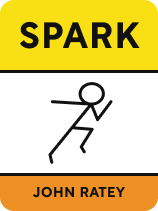

This article is an excerpt from the Shortform book guide to "Spark" by John Ratey. Shortform has the world's best summaries and analyses of books you should be reading.
Like this article? Sign up for a free trial here .
What is John Ratey’s Spark about? What is the key message to take away from the book?
Spark by John Ratey is a look at the science behind what exercise does to our brains and what it means for our mental health. Ratey derives his insights from observations of his own patients as well as from scientific discoveries that were revolutionizing neuroscience around the time of the book’s publication in 2008.
Below is a brief overview of Spark by John Ratey.
Spark: The Revolutionary New Science of Exercise and the Brain
Spark by John Ratey delves into the science behind exercise and brain health. Ratey argues that exercise is not only good for the body, but it’s also good for the brain. Your brain is the dominant control center of your body, and its health directly affects, among other things, your mood, your attention, and your ability to learn. Ratey argues that your overall physical well-being is so intimately linked to brain function that maintaining it should be a top priority, and he hopes to convince us to make exercise a routine part of our lives.
Humans Are Built to Move: The Mind-Body Connection
Ratey argues that our brains are optimized by exercise because of the way humans evolved. When our ancestors ran down their prey in prehistory, their bodies and brains worked in concert. They not only had to sustain high levels of physical exertion, but they also had to read and respond to their environment quickly and accurately to survive. The brain and body, therefore, became well-conditioned to support each other in a virtuous circle.
Today, our brains still operate as our ancestors’ did. The same neurological systems they used to hunt and gather are the ones we use to program computers, and our minds still function best in a mode of persistent activity. However, in our modern era we no longer face the same challenges our ancestors did. We may not share our ancestors’ reasons for moving, but we do share their need to move on a fundamental, biological level.
Exercise Helps Us Learn
Ratey was inspired to study the connection between exercise and the brain after reading about Chicago’s Naperville public high school. Their novel fitness-first approach to gym class focused on getting students moving through regular exercise. A direct result of this improved fitness was significant gains in student performance. In a 1999 standardized test comparing Naperville students’ science and math knowledge with that of students from different countries, Naperville finished first in the world in science and sixth in math. Ratey concluded that the school’s focus on physical health was in large part the reason for their academic success.
On further research, Ratey found that exercise helps us learn in primarily two ways:
- Exercise strengthens neurons
- Exercise stimulates the growth of new neurons
Exercise Strengthens Neurons
The brain uses a network of specialized cells called neurons to communicate across its various regions. Communication happens when electrical signals move along this network from one neuron to another, crossing the gaps (synapses) between the neurons by jumping from the signaling ends (axons) of one neuron to the receptors (dendrites) of another. Given this system, Ratey observes that increasing the strength of the signal and the number of receivers on a neuron improves the neural network.
In recent decades, researchers have identified how exercise improves the neural network: It stimulates the production of a protein called brain-derived neurotrophic factor (BDNF), which increases the growth of dendrites on neurons and enhances the electrical voltage of the signal generated in the neuron. This results in more neural connections and better neural communication. In technical terms, this is called “synaptic plasticity.”
Exercise Stimulates the Growth of New Neurons
Before the late 1990s, scientists didn’t believe the adult brain could produce new neurons—they thought neuron production (neurogenesis) was purely a phenomenon of a child’s growing brain. Discoveries since that time, however, have overturned this belief, confirming that new neurons are born in adulthood.
Most neurons created during adulthood, however, only survive for a short time. Their survival is determined by whether or not they fire (generate an electrical signal): If they don’t, they die.
Ratey explains that exercise has been shown to stimulate neurogenesis in the lab and suggests that the effects of BDNF on the neural network (increasing the number of dendrites and enhancing the electrical signal) enable those baby neurons to fire and survive. More BDNF, therefore, results in more functioning, stable neurons.
Furthermore, exercise also releases two other growth factors—vascular endothelial growth factor (VEGF) and fibroblast growth factor (FGF-2)—that stimulate the process of cell division, which also powers neurogenesis.
Exercise Regulates Our Stress Response
In addition to helping us learn, Ratey believes exercise has a powerful role in controlling the brain’s stress response system. To help readers understand this, he first offers a clear definition of the term stress.
Ratey defines stress as anything that initiates activity at the level of our cells. By this definition, our environments present countless stressors. For example, when we move, we stress both our muscles and the brain cells involved in controlling that movement. When we eat vegetables such as eggplant, our cells activate as they work to process toxins the plant has created to protect itself. When we hear an unexpected noise, our brains initiate a stress response as they work to assess the source of the noise and whatever threat it might pose.
(Shortform note: Another biological understanding of stress is that it’s anything that threatens homeostasis. Homeostasis is a state in which the body’s physical systems are in balance. So anything that disrupts that maintenance is a stressor.)
Under this narrow, biological definition, stress is neither inherently good or bad; it’s a fundamental biological process. If the body can handle the effects of the stress—for example, if cells can clean up the waste produced by oxidative stress—then the stress won’t have negative effects at the cellular level. It’s when the body can’t keep up with the cellular effects of stress that it starts to feel negative effects. When that happens, we end up feeling stressed, which Ratey explains is a psychological and emotional reaction to cellular stress events.
(Shortform note: Some experts take a different view of just how stress is neither good nor bad. Defining it as a psychological challenge, they observe that people who seem to handle stress well are motivated by it—seeing it as an opportunity to rise to a challenge. By contrast, those who don’t handle stress well are demotivated by such a challenge. These experts suggest that cognitive reframing (thinking of the stressor differently) can help to make stress work for you.)
2 Kinds of Stress
Ratey points out that there are two different types of stress. Understanding the difference between the two enables us to understand how exercise works to control stress.
Acute Stress Can Be Good
Short-term stress is known as acute. It has a beginning and ending, and the cell is able to clean up the oxidative byproducts of burning the fuel it took to stay active. Ratey points out that living systems, like our bodies, need to be exposed to acute stress to become well-conditioned. We can’t survive without it. Mild stress—whether through exposure to natural toxins in vegetables or challenges to our muscles—strengthens our bodies and minds.
Chronic Stress Is Bad
The second type of stress is long-term, and it’s harmful to your brain. This is known as chronic stress. When your body is engaged in a high-stress response, it releases chemicals in a targeted way and for a narrow purpose—survival. In this state, the hormonal and neurochemical equilibrium of your body is askew. Too much time like this is damaging, as your cells never get the chance to recover. Excess cortisol in the brain, for instance, corrodes neurons, causing numerous problems such as memory loss, trouble focusing, and learning difficulties.
(Shortform note: John Medina discusses this in Brain Rules, noting that stress hormones released by chronic stress tend to especially damage the hippocampus, which is central to our ability to learn. At its most extreme, he notes, chronic stress can kill cells in the hippocampus, disrupt their neural connections, and disable the gene that creates new cells.)
How Exercise Helps With Stress
Given the risks associated with chronic stress, it’s important to understand how exercise can be used to limit our exposure to its negative effects.
Exercise Calms Our Mind and Body
As we saw earlier, exercise stimulates the release of proteins that grow and strengthen the neural network: BDNF, VEGF, and FGF-2. This reduces the likelihood that our brains will misperceive threats or lose control of the body’s stress-response system. Beyond this, Ratey argues, exercise counteracts the disempowering effect stress and fear has on your mind. As an activity you voluntarily pursue, it’s empowering, which reinforces a positive feedback loop that bolsters your resistance to the stressors of life.
Exercise Is a Mild Stress
Ratey contends that exercise, as a form of mild acute stress, is like an inoculant that builds resilience, toning all the machinery of the brain and body and tamping down our trigger-happy stress response system. He points out that this effect is largely a consequence of the way our cells recover after exercise-induced stress—this is part of the activity and recovery process of the body’s stress response. In addition to this recovery mechanism, the broader effects of exercise on the brain condition us to handle stress better.
Exercise Improves Our Mental Health
In this section, we’ll explore Ratey’s theories on how and why exercise benefits our mental health. We’ll first discuss neurotransmitters, which are largely responsible for psychiatric well-being, and then we’ll briefly touch on the various mental health conditions Ratey addresses, summarizing the main ways exercise helps. In each case, Ratey refers to the science and to stories from his clinical practice to make his point.
(Shortform note: Defining stress narrowly, in terms of cell biology, positions stress as a through-line in all the mental health concerns Ratey goes on to discuss. He isn’t as explicit about this as he could be, but bear in mind that each condition has some form of stress as a component—whether it’s a cause, a symptom, or some combination of the two. Accordingly, the way exercise combats the negative effects of stress generally applies to the other concerns he explores, such as anxiety, depression, and so on.)
Exercise Balances Neurotransmitters in the Brain
Neurotransmitters are chemicals that regulate the signals passing along the brain’s neural network. When there’s an imbalance of neurotransmitters we can experience difficulties such as anxiety, depression, scattered focus, memory loss, and more. Too much glutamate, for instance, leads to a signal overload that can cause excitotoxic stress. Too little gamma-aminobutyric acid (GABA) undercuts your brain’s ability to stop the signals.
The functioning of these two neurotransmitters is further regulated by three other neurotransmitters you may have heard of: serotonin, norepinephrine, and dopamine. The messages that end up getting transmitted throughout the brain are largely regulated by these three chemicals. There’s overlap between their functions, but:
- Serotonin is largely responsible for signals having to do with mood.
- Norepinephrine influences attention and arousal.
- Dopamine works in the realm of motivation.
These are the three chemicals targeted by most psychiatric medications. Selective serotonin reuptake inhibitors (SSRIs) such as Lexapro, for example, are used to regulate the disruptive mood states associated with depression by increasing serotonin levels in the brain.
Ratey supports the use of such medications and is careful not to suggest that exercise should be relied on to the exclusion of drugs in particular cases. Such decisions are best made under the guidance of physicians familiar with the case. Nevertheless, Ratey argues that exercise helps to bring all these chemicals into balance by stimulating the release of each of these neurotransmitters in optimal amounts for mental health.
Anxiety
Anxiety is a component of your brain’s stress-response system; it’s a natural response to legitimate threats. When it becomes overly heightened, turning into an undue fear response to misperceived threats, it becomes a disorder. According to Ratey, exercise alleviates both the symptoms and the state of anxiety by calming our bodies, increasing our sense of autonomy, and retraining our brains to better regulate and reduce fear signals.
Depression
Ratey argues that depression should be thought of as a breakdown in neural communication. In the depressed brain, the neural network breaks down, disconnecting brain regions from one another. This causes critical parts of the brain to atrophy. A lack of neurotransmitters compounds this state leaving the brain unable to kickstart its attention and motivation tools. The effects of exercise can break this vicious circle by rebuilding neural connections, restoring healthy brain chemistry, powering neurogenesis, and nurturing a sense of hope.
Addiction
Addiction co-opts our attention resources by making the brain focus exclusively on the object of addiction. For the drug addict, for instance, an overload of dopamine in the brain—triggered by the drug of choice—tricks the brain into attending only to that trigger as if it’s a matter of life or death. Exercise breaks this fixation by retraining the brain’s motivation system—weaning it off an unnatural dopamine fix in favor of a balance of healthy neurochemicals.
(Shortform note: Substance abuse and addiction are common markers of trauma. Bessel van der Kolk discusses the unique nature of traumatic memories in The Body Keeps the Score. Such memories alter the makeup of the brain itself and often leave the victim feeling fearful and powerless. A key aspect of Ratey’s insights on exercise and addiction is that exercise can give us a sense of accomplishment that helps to overcome this powerless feeling.)
ADHD
Ratey argues that people with ADHD have functional but poorly regulated attention systems in the brain. This is caused by low levels of dopamine and norepinephrine in the ADHD brain, which undermine its ability to prioritize among distractions, sustain motivation, and combat impulses. Exercise causes brain cells to secrete these key neurotransmitters, builds coordination between the brain’s attention resources, and conditions the systems that support continued attention regulation. In particular, exercises requiring some structure, risk, or coordination (for example, martial arts) seem to be especially effective in harnessing the attention resources of the ADHD brain.
2 Special Cases: Aging and Women’s Issues
We’ve seen how exercise helps us learn, regulate stress, and maintain mental health. Two significant consequences of this that Ratey discusses are that exercise protects the aging brain and helps regulate the unique hormonal fluctuations women face over the course of their lives.
Getting Old
For all of us, Ratey contends that the toll a lifetime of stress takes on the brain becomes hard to escape. Characteristic features of aging, such as cognitive decline, depression, and dementia, are at least partially caused by the body’s cells being worn down by the stressors of life.
Ratey argues that as your body becomes equipped to handle stress through exercise, it becomes better able to preserve its resources against the negative effects of aging. For example, as neurons wear out in the brain, the neural network thins—exercise counteracts this loss by supporting neuroplasticity and neurogenesis.
(Shortform note: Researchers have recently found that exercise has a neuroprotective role in staving off cell degeneration caused especially by aging, Parkinson’s, and Alzheimer’s. They advise that exercise should be used as an add-on therapy, together with other forms of treatment, to generate the most benefits.)
Women
Women face unique stressors related to menstruation, pregnancy, and menopause. The hormone fluctuations that attend each of these can lead to anxiety, depression, and attention issues, among other things. During pregnancy, maternal stress can have severe impacts on the fetus.
(Shortform note: A recent analysis found a strong correlation between exercise and the reduction of estrogen. High levels of estrogen have been linked to breast cancer. Subjects who exercised—especially at higher intensities—showed a modest reduction in the total levels of one form of estrogen.)
Ratey contends that exercise has a powerfully stabilizing effect in the midst of all the hormonal fluctuations women face in life. Strikingly, he notes that some data suggest it’s even capable of reversing some of the negative effects fetal alcohol syndrome has on the baby.
(Shortform note: Since the publication of Spark, researchers have continued to examine the impact of exercise on children with executive-function disorders, including fetal alcohol syndrome (FASD). The analysis found that children with FASD who exercised showed major gains in the areas of working memory and response inhibition, and they were also significant for attention. Another noteworthy finding of the analysis is that exercise-induced gains were higher for children with FASD and autism-spectrum disorders than they were for children with ADHD.)
Building a Routine and Making It Stick
We’ve seen numerous ways exercise supports brain health and contributes to our overall well-being—whether we’re facing anxiety, addiction, depression, or simply the desire to grow and learn, exercise helps.
In this final section of the guide we’ll look at the recommendations Ratey offers for building exercise into our life routines.
We’ll see:
- What form of exercise is best for reaping the benefits Ratey explores
- What your maximum heart rate is and how to use it to determine your most effective workout
- Some ideas for incorporating exercise into your daily routine
Aerobic Exercise Is Best
Ratey argues that not all forms of exercise are equally effective for optimizing brain function. Studies show that aerobic exercise is best. This isn’t to say that other forms of exercise aren’t beneficial, it’s just that aerobic exercise is currently understood to be optimal for tapping into the benefits we’ve explored.
(Shortform note: Researchers have demonstrated that both endurance exercise (e.g. running) and resistance exercise (e.g. weight lifting) increased the release of factors such as brain-derived neurotrophic factor and insulin-like growth factor. These proteins are critical for strengthening the neural network and reversing cell deterioration. This more up-to-date information suggests that resistance exercise should be included in your exercise routines.)
The benefits of exercise are distributed among three zones of intensity—the more powerful the workout, the more powerful the body’s response. We’ll take a look at how you can determine the intensity of your workout in the following subsection on heart rate.
- Low-intensity exercises are the baseline. At this level, your body begins releasing the neurotransmitters and factors we’ve discussed, and your body starts improving its metabolic function by burning fat. This helps to restore, maintain, and improve your brain’s function, setting the groundwork for more intense exercise.
- Medium-intensity exercise ramps up these processes and initiates more. At this intensity level, your body is exposed to a good amount of useful stress—the kind that builds resilience in your brain’s systems. New blood vessels are built, the process of neurogenesis is encouraged, your body’s stress response is conditioned and relaxed, and endocannabinoids are released.
- High-intensity workouts are powerful and must be handled with care. At this level, your body can reach a point where it becomes oxygen-deprived and your metabolism enters an anaerobic state. You feel this as muscle burn. Too much time in this state can be damaging for the body, but in moderate doses, it can be extremely beneficial. Accordingly, when you’re in the middle of a high-intensity workout, it’s best to stay just below this point most of the time and occasionally pass it.
(Shortform note: In Awaken the Giant Within, Tony Robbins suggests that you build a routine of exercise first on moderate-intensity aerobic exercise for a period of two to eight months. Laying the groundwork here, he suggests, will prepare you for engaging in more high-intensity anaerobic exercise.)
A reliable description of the sweet spot for a high-intensity workout is when the exercise feels “somewhat hard.” In addition to all the other effects we’ve discussed, during such a workout the body begins releasing human growth hormone (HGH), which burns fat, increases muscle growth, and grows your brain.
Ratey is careful to remind his readers that doing something is better than doing nothing. Don’t get discouraged if you can’t reach or maintain a high-intensity workout yet. As we’ve seen all along the way, the brain is optimized for movement, so the key is to move.
Determining Your Heart Rate
Because individual fitness levels vary, an exercise that’s intense for one person won’t be intense for another. You can determine the intensity of your workout by measuring your heart rate—the faster your heart is beating, the harder you’re working.
The first step is determining your maximum heart rate—the hardest your heart can work. This varies according to your age and overall health, but Ratey shares a rule of thumb for calculating it: Subtract your current age from 220. The intensity of your exercise is determined as a percentage of that maximum rate. The higher the percentage, the more intense the workout. This is simply calculated by multiplying your maximum heart rate by a decimal equivalent to the percentage you’re looking to achieve.
Let’s look at walking, jogging, and running as templates for intensity. Keep in mind that other forms of aerobic exercise can put your heart rate into these different zones (for example, jumping rope or cycling).
- Walking should put your heart rate between 55% and 65% of your maximum. This is considered low intensity.
- Jogging is 65% to 75%. This is medium intensity.
- Running is 75% to 90%. This is high intensity.
Making Exercise Stick
Determining the best way to get exercise into your life is a personal decision. With that said, there are several tips Ratey suggests throughout Spark that may help augment its effectiveness and make it stick.
Do something you enjoy.
This may sound simple, but if you enjoy riding a bike and despise running, then ride a bike. The more you enjoy it, the more likely you are to do it.
Try new things.
Variety can keep it interesting, and interest can go a long way toward keeping you at it. So go ahead and learn a new skill or try a new routine. You may discover other forms of exercise you like.
Do it with others.
Humans aren’t only built for movement, they’re also built for social interaction. Exercising with others encourages accountability and magnifies the neurochemical effects of the workout–and it can make it more fun.
Keep at it.
Sometimes the best way to stick to a routine is to simply remind yourself that you can’t afford not to. When it comes to your mind and exercising, just remember that your body was built to move—it needs to move. So, whatever you do, keep it up. Don’t berate yourself if you miss a day or two, just get back to it as soon as you can.
(Shortform note: Some experts offer other tips for sticking to an exercise routine that can help you keep at it even when you don’t want to. For instance, they recommend that you set small goals for yourself, make charts of your progress, and give yourself meaningful rewards for achieving your goals.)

———End of Preview———
Like what you just read? Read the rest of the world's best book summary and analysis of John Ratey's "Spark" at Shortform .
Here's what you'll find in our full Spark summary :
- How exercising can help with addiction, anxiety, and depression
- A look at how exercise optimizes brain function and supports mental health
- What exercises are the most beneficial, and how to stick to a routine






